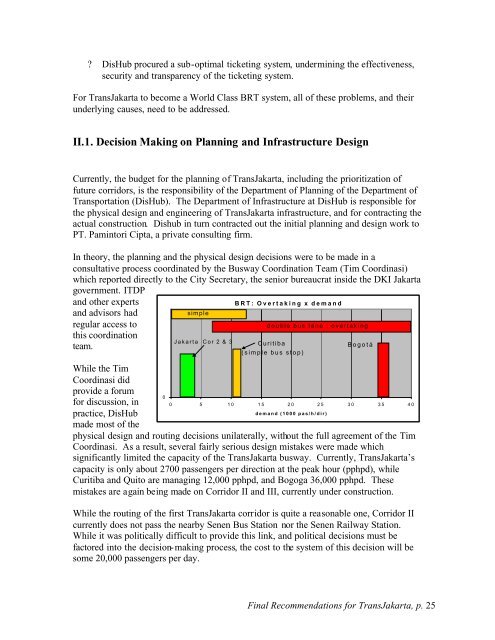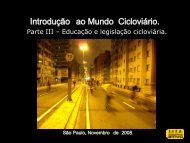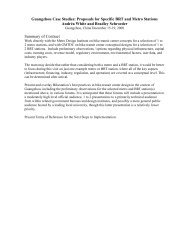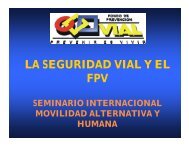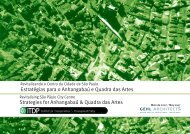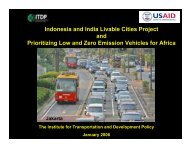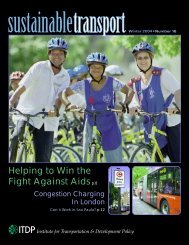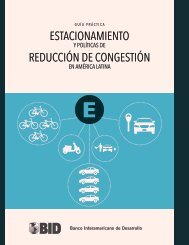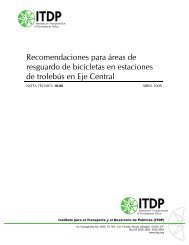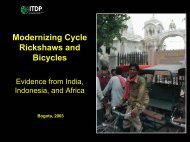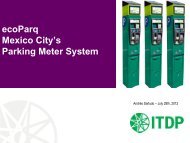Making TransJakarta a World Class BRT System - ITDP | Institute for ...
Making TransJakarta a World Class BRT System - ITDP | Institute for ...
Making TransJakarta a World Class BRT System - ITDP | Institute for ...
You also want an ePaper? Increase the reach of your titles
YUMPU automatically turns print PDFs into web optimized ePapers that Google loves.
? DisHub procured a sub-optimal ticketing system, undermining the effectiveness,<br />
security and transparency of the ticketing system.<br />
For <strong>TransJakarta</strong> to become a <strong>World</strong> <strong>Class</strong> <strong>BRT</strong> system, all of these problems, and their<br />
underlying causes, need to be addressed.<br />
II.1. Decision <strong>Making</strong> on Planning and Infrastructure Design<br />
Currently, the budget <strong>for</strong> the planning of <strong>TransJakarta</strong>, including the prioritization of<br />
future corridors, is the responsibility of the Department of Planning of the Department of<br />
Transportation (DisHub). The Department of Infrastructure at DisHub is responsible <strong>for</strong><br />
the physical design and engineering of <strong>TransJakarta</strong> infrastructure, and <strong>for</strong> contracting the<br />
actual construction. Dishub in turn contracted out the initial planning and design work to<br />
PT. Pamintori Cipta, a private consulting firm.<br />
In theory, the planning and the physical design decisions were to be made in a<br />
consultative process coordinated by the Busway Coordination Team (Tim Coordinasi)<br />
which reported directly to the City Secretary, the senior bureaucrat inside the DKI Jakarta<br />
government. <strong>ITDP</strong><br />
and other experts<br />
<strong>BRT</strong>: Overtaking x demand<br />
and advisors had<br />
simple<br />
regular access to<br />
double bus lane : overtaking<br />
this coordination<br />
team.<br />
Jakarta Cor 2 & 3 Curitiba<br />
Bogotá<br />
(simple bus stop)<br />
While the Tim<br />
Coordinasi did<br />
provide a <strong>for</strong>um<br />
0<br />
<strong>for</strong> discussion, in<br />
0 5 10 15 20 25 30 35 40<br />
practice, DisHub<br />
demand (1000 pas/h/dir)<br />
made most of the<br />
physical design and routing decisions unilaterally, without the full agreement of the Tim<br />
Coordinasi. As a result, several fairly serious design mistakes were made which<br />
significantly limited the capacity of the <strong>TransJakarta</strong> busway. Currently, <strong>TransJakarta</strong>’s<br />
capacity is only about 2700 passengers per direction at the peak hour (pphpd), while<br />
Curitiba and Quito are managing 12,000 pphpd, and Bogoga 36,000 pphpd. These<br />
mistakes are again being made on Corridor II and III, currently under construction.<br />
While the routing of the first <strong>TransJakarta</strong> corridor is quite a reasonable one, Corridor II<br />
currently does not pass the nearby Senen Bus Station nor the Senen Railway Station.<br />
While it was politically difficult to provide this link, and political decisions must be<br />
factored into the decision-making process, the cost to the system of this decision will be<br />
some 20,000 passengers per day.<br />
Final Recommendations <strong>for</strong> <strong>TransJakarta</strong>, p. 25


